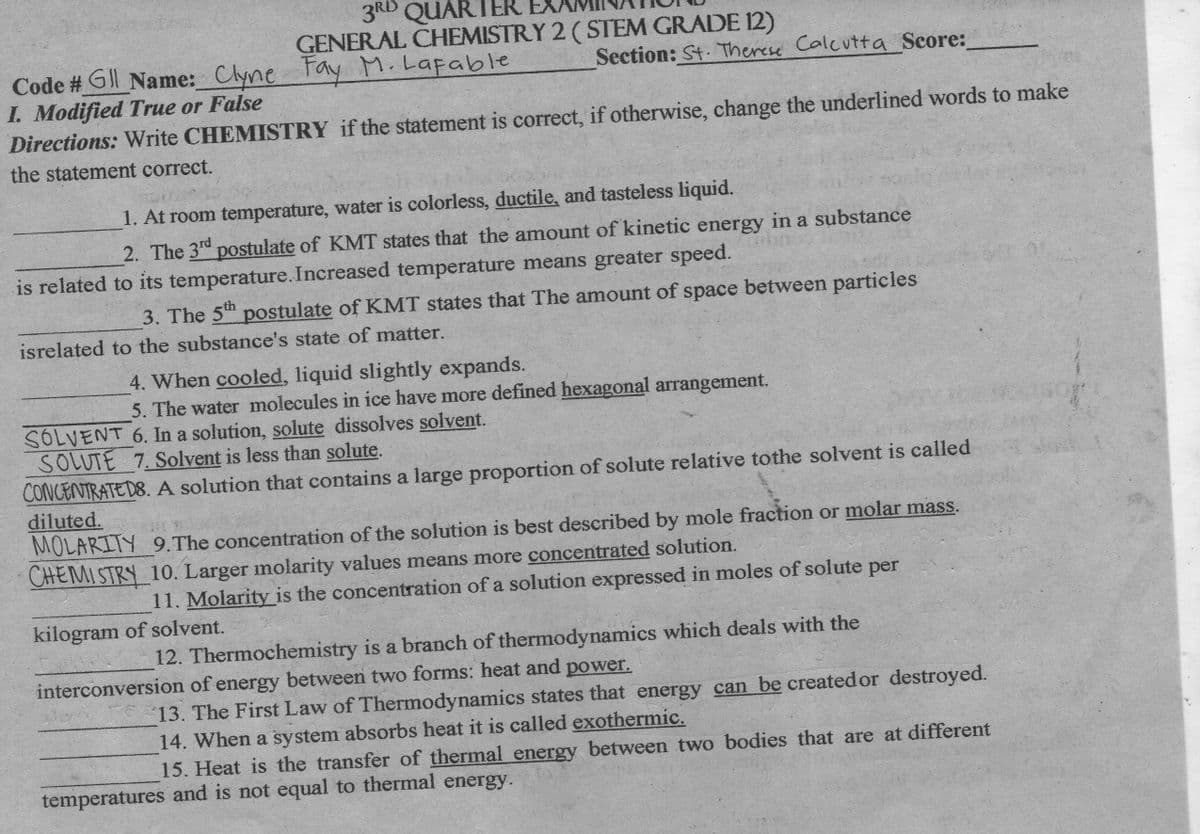interconversion of energy between two forms: heat alu 13. The First Law of Thermodynamics states that energy can be created or destroyed. 14. When a system absorbs heat it is called exothermic. 15. Heat is the transfer of thermal energy between two bodies that are at different temperatures and is not equal to thermal energy.
interconversion of energy between two forms: heat alu 13. The First Law of Thermodynamics states that energy can be created or destroyed. 14. When a system absorbs heat it is called exothermic. 15. Heat is the transfer of thermal energy between two bodies that are at different temperatures and is not equal to thermal energy.
Chemistry: The Molecular Science
5th Edition
ISBN:9781285199047
Author:John W. Moore, Conrad L. Stanitski
Publisher:John W. Moore, Conrad L. Stanitski
Chapter8: Properties Of Gases
Section: Chapter Questions
Problem 75QRT
Related questions
Question
100%
MODIFIED TRUE OR FALSE
13 AND 15 ONLY

Transcribed Image Text:3RD QUARTER
GENERAL CHEMISTRY 2 (STEM GRADE 12)
Fay M. Lafable
Section: St. Therese Calcutta Score:
Code # G Name: Clyne
I. Modified True or False
Directions: Write CHEMISTRY if the statement is correct, if otherwise, change the underlined words to make
the statement correct.
1. At room temperature, water is colorless, ductile, and tasteless liquid.
2. The 3d postulate of KMT states that the amount of kinetic energy in a substance
is related to its temperature.Increased temperature means greater speed.
3. The 5th postulate of KMT states that The amount of space between particles
isrelated to the substance's state of matter.
4. When cooled, liquid slightly expands.
5. The water molecules in ice have more defined hexagonal arrangement.
SOLVENT 6. In a solution, solute dissolves solvent.
SOLUTE 7. Solvent is less than solute.
CONCENTRATED8. A solution that contains a large proportion of solute relative tothe solvent is called
diluted.
MOLARITY 9.The concentration of the solution is best described by mole fraction or molar mass.
CHEMI STRY 10. Larger molarity values means more concentrated solution.
11. Molarityis the concentration of a solution expressed in moles of solute per
kilogram of solvent.
12. Thermochemistry is a branch of thermodynamics which deals with the
interconversion of energy between two forms: heat and power.
13. The First Law of Thermodynamics states that energy can be createdor destroyed.
14. When a system absorbs heat it is called exothermic.
15. Heat is the transfer of thermal energy between two bodies that are at different
temperatures and is not equal to thermal energy.
Expert Solution
This question has been solved!
Explore an expertly crafted, step-by-step solution for a thorough understanding of key concepts.
Step by step
Solved in 2 steps

Knowledge Booster
Learn more about
Need a deep-dive on the concept behind this application? Look no further. Learn more about this topic, chemistry and related others by exploring similar questions and additional content below.Recommended textbooks for you

Chemistry: The Molecular Science
Chemistry
ISBN:
9781285199047
Author:
John W. Moore, Conrad L. Stanitski
Publisher:
Cengage Learning

Introductory Chemistry: A Foundation
Chemistry
ISBN:
9781285199030
Author:
Steven S. Zumdahl, Donald J. DeCoste
Publisher:
Cengage Learning

Introduction to General, Organic and Biochemistry
Chemistry
ISBN:
9781285869759
Author:
Frederick A. Bettelheim, William H. Brown, Mary K. Campbell, Shawn O. Farrell, Omar Torres
Publisher:
Cengage Learning

Chemistry: The Molecular Science
Chemistry
ISBN:
9781285199047
Author:
John W. Moore, Conrad L. Stanitski
Publisher:
Cengage Learning

Introductory Chemistry: A Foundation
Chemistry
ISBN:
9781285199030
Author:
Steven S. Zumdahl, Donald J. DeCoste
Publisher:
Cengage Learning

Introduction to General, Organic and Biochemistry
Chemistry
ISBN:
9781285869759
Author:
Frederick A. Bettelheim, William H. Brown, Mary K. Campbell, Shawn O. Farrell, Omar Torres
Publisher:
Cengage Learning

Chemistry by OpenStax (2015-05-04)
Chemistry
ISBN:
9781938168390
Author:
Klaus Theopold, Richard H Langley, Paul Flowers, William R. Robinson, Mark Blaser
Publisher:
OpenStax
